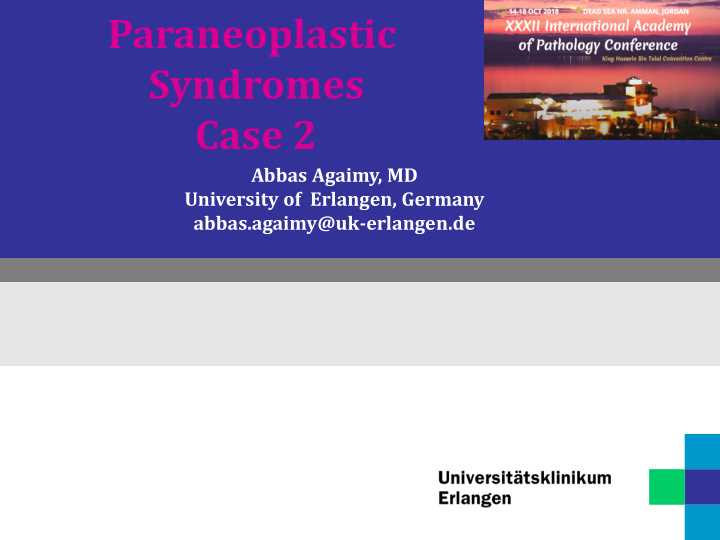



Paraneoplastic Syndromes Case 2 Abbas Agaimy, MD University of Erlangen, Germany abbas.agaimy@uk-erlangen.de
The main message of the cases is to demonstrate how paraneoplasia was „a key“ to correctly recognize and properly classify the neoplasm under consideration
Agaimy , Case #2 • 39 yo male. • Heart transplantation 40 months ago. • Uneventful follow-up with endomyocardial biopsies. • Admitted with rapid worsening of general condition. • EMB: no evidence of acute graft rejection.
Unexplained hypercalcemia of 4.0 mmol/l (reference range, 2.1 to 2.7 mmol/l)
Normal parathyroid function. Serum parathyroid hormone-related protein (PTHrp) significantly elevated (241 pg/ml; reference value <57).
Multiple irregular liver nodules CT abdomen+thorax: Multiple enlarged • mediastinal, hilar and para-aortic lymph nodes. Multiple liver nodules. • Core needle biopsies • obtained from a liver nodule.
Despite maximum interdisciplinary therapy, the patient died of supervening multi-organ failure within one week. An autopsy was not performed.
Liver biopsy: Large epithelioid cells In nests and abortive gland-like pattern
Scattered rhabdoid inclusions
brisk mitotic activity
AE1/AE3 CK20 Dot- like „rhabdoid“ pattern
o GATA3 & SATB2 focal + o MMR intact CK7- o Poorly difreentaited carcinoma with rhabdoid cell features o IHC suggestive of GI tract origin HepPar1-
Affects 44% of patients with cancer, usually those with advanced disease Humoral type: 80% Peptides secreted by tumor (80% of cases): o PTH-rP (ectopic) 20% o 1,25 vit D (ectopic) o PTH (PT or ectopic) <1% Secondary type (20%): <1% Increased bone metabolism due to mets
Paraneoplastic hypercalcemia (PNH) Tumors reported to be associated with PNH • Small cell carcinoma of the ovary hypercalcemic type (SCCOHT): up to 75% of cases display PNH. • Most of human T-cell lymphotrophic virus type I (HTLV-I)- associated adult T-cell leukemia/lymphoma (ATL). • Diverse carcinoma types. • GI stromal tumors (6 reported cases).
Paraneoplastic hypercalcemia (PNH) Tumors reported to be associated with PNH • Small cell carcinoma of the ovary hypercalcemic type (SCCOHT): up to 75% of cases display PNH. • Most of human T-cell lymphotrophic virus type I (HTLV-I)- associated adult T-cell leukemia/lymphoma (ATL). • Diverse carcinoma types. • GI stromal tumors (6 reported cases).
• Age range:9-43 yrs (mean, 24) • 99% unilateral • Hypercalcemia in 62%-75% • Extraovarian spread: 50%
Small cell carcinoma of ovary, classical type Follicle-like spaces simulating juvenile granulosa cell tumor
Large rhabdoid cells present in 50%: SCCOHT Minor in 25% Moderate in 16% Predominated in 12% (=so-called large cell variant) Our case
SMARCA4
Our case SMARCA4 SMARCA2
SMARCA4: a core subunit of the SWI/SNF chromatin remodelling complex SMARCA4 loss (inactivation) in: o SCCOHT (100%) o Subsets of pediatric AT/RTs (2%) o Undifferentiated thoracopulmonary malignancies (100%) o 5-10% of NSCLC o Subset of sinonasal undiff carcinomas (rare) o Subset of dedifferentiated carcinomas: • GI tract • Uterus • Kidney • Bladder
Do not ask how a neoplasm look-alike but ask why it looks alike. Juan Rosai, MD Any questions?
Recommend
More recommend